News
Style Guide for Authors
more
Financial Statement of 2019
more
Available Now! Down Fell the Statue of Goliath - Hungarian Poets and Writers on the Revolution of 1956
more
Subscription
Hungarian Review annual subscriptions for six issues, including postage (choose one):

15 January 2016
Ödön Lechner: Maverick, Dreamer, Patriot – An Architect of Modernisation
For more than a century the complexity of Ödön Lechner’s experiment with a “Hungarian style” has generated fierce theoretical debates, often strongly influenced by contemporary politics. It is the sort of topic that inspires each new generation of scholars to explore anew the construction of nationalism in the fine arts.
Creating a “style for the nation” was not an exclusively Hungarian endeavour in the second half of the nineteenth century, but Ödön Lechner’s aesthetically outstanding oeuvre has often been regarded as an appropriate case study for such an undertaking. Especially since the cultural heritage of the small countries formerly locked up behind the Iron Curtain became accessible to the global community of academic research, Lechner has become the best-known Hungarian architect. This recognition was not so much due to the undoubted artistic merit of his oeuvre, but rather because the latter seemed to offer an obvious and appropriate case study for the illustration of cultural nationalism.1
Since the enthusiasm for nation-building as a fashionable topic for study that had flourished in the early 1990s evaporated, almost anything that could be associated with cultural nationalism has come to be tarred with the brush of conservatism and anti-modernism. The process of examining the cultural heritage of the small nations of Central Europe has consequently become increasingly controversial. We would nevertheless do well to keep in mind that “national style” was by no means an obsession limited to the smaller states, or to Central Europe, but a widespread phenomenon of the 19th century in Europe as a whole (Wiegmann, Taine etc.).2
Starting with Romanticism3 indeed it can be regarded (especially around 1900) as a core issue of the age, an organic part of the cultural modernisation of the individual nations of Europe that was embraced by the progressive cultural elite of the day. This study will explore a number of related problems concerning this issue.
In spite of the sparse documentation of Lechner’s life, it is evident that both his intellectual and aesthetic approach to his task was gradually changing as he absorbed diverse architectural and cultural theories from the late 1870s until the First World War. Any one of these influences opened up a broad conceptual horizon (intellectual, political, artistic and even technical), elements of which are being analysed in greater detail by present-day scolarship. They include Orientalism and ethnographic issues, as well as the impact of political events or of briefly fashionable ideologies of national culture. Finally I will analyse in details his influence and his reception.
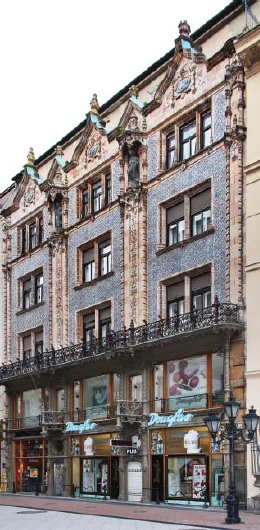
Thonet house, principal façade, 1989–1991, 58 Váci utca, Budapest
About fifty years ago, when Art Nouveau and Secession were rehabilitated by architects and academe, Lechner’s unique style once again became highly appreciated, praised indeed by Hungarian art historians as a synthesis between national culture and modernity. In fact Lechner’s efforts to create an architectural style which was uniquely “magyar” had never really been forgotten in his homeland, since his followers (known as the “Lechner School”), and some other architects sensitive to local vernacular traditions (even in the interwar period), had attempted to offer new solutions to the concept of a national style. These endeavours were of course in sharp contradiction to the ideals and practice of international modernity at that time and later also suspect as examples of “bourgeois individualism” in architecture during the early decades of Communism in Hungary.
A change in evaluation occurred in the 1970s, when a less dogmatic intellectual climate encouraged a new generation of architects to rediscover the architectural heritage of the decades around 1900. They were inspired by its versatility, its quality and its broad intellectual sweep. Lechner’s oeuvre became their flagship, a Paradebeispiel of the synthesis between “modern” and “national” artistic trends adumbrating a vision of a better future for the nation. Nevertheless because of sparse historical documentation and missing personal sources (especially for his formative years and his years in Paris), the much anticipated scholarly monograph on Lechner’s oeuvre was never written.4
Notwithstanding that, we should pay homage to a clutch of authors who published excellent books or studies on Lechner, notably János Gerle and Márta Nemes.5 I would especially like to stress the contribution of János Gerle,6 who wrote an outstanding essay in an anthology he compiled of Lechner’s own texts and important texts about him – a book which still offers the most reliable survey not only of the life of the master, but also of the reception of his oeuvre up to the year of its publication in 2003. Indeed, up to his death in 2012, János Gerle did more for the rediscovery of Hungarian fin-de-siècle architecture7 than any other historian, and his 2003 text is still valid and relevant.8 As a trained architect and a great stylist, he never fell into the trap of churning out a case study to suit the latest academic fashion, but offered an illuminating analysis of his buildings and his style.
Since Gerle’s death, not much that is new has been produced by Hungarian architectural historians on Lechner’s remarkable oeuvre until now. His buildings, the surviving monuments of a unique architectural vision, are in most cases endangered, often indeed the prey of financial greed and irresponsible neglect.
A pioneering contribution to the analysis of the architecture of Central Europe in the age of Historicism and at the fin-de-siècle has been made by Ákos Moravánszky’s books, which are still the best sources in English on the region’s pluralistic stylistic trends, whereby Central Europe emerges as an experimental hub of trans-European architectural experiments.9
With regard to such influences, I only have space here to highlight a few parallel attempts by the Czechs to create a style for the nation, attempts that also occurred in other countries of Europe, but especially within the Austro-Hungarian Empire.
I.
It is a common consensus among all the authors writing on Lechner, that he succeeded in creating a synthesis which transcended the diversity of detail in his style and cohered in an aesthetically pleasing Gesamtkunstwerk that was sufficiently convincing to attract followers – and indeed became an ideal that inspired generations of Hungarian architects.
Lechner’s oeuvre encompassed two cultural periods, the age of Historicism and the age of Art Nouveau; because his formative years fall in the period when Historicism was at its zenith, the earliest parallels to his stylistic experiments are drawn from Historicism and date from the 1870s and 1880s.
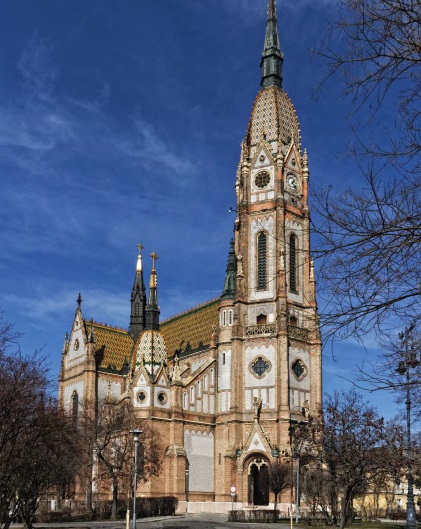
Kőbánya Parish Church, Budapest, 1894–1897

Kecskemét City Hall, 1893–1897

Museum of Applied Arts, Budapest, 1893–1896. Central section of the principal façade
Lechner was born into a patriotic family with a strong Hungarian identity,10 which made him especially receptive to intellectual and emotional influences which accorded with his inner vocation to work for the good of the nation. The “nation” as an imaginary, but also an actually existing entity was an experienced reality for most educated citizens of any country of Europe in the second half of the 19th century. It was also an organic part of the modernisation project of communities and individuals, especially as envisaged by the cultural elite. Although the possibility of creating a new style (any new style) was fiercely debated in the architectural profession, the regional differences of historical styles provided a basis for a more pronounced national style (Hippolyte Taine’s concept of the “milieu” is also a reference point here).11 It is clear that attempts to construct a national style were intensified by the demands of French architects in the 1870s, and especially when they were working on the concepts of the World Fair of 1878. Lechner could hardly have been unaware of this during his years in Paris (1875–1879).12 For the French professional elite, architecture was the hallmark of national identity; and the same had become true of the other European nations from 1867 onwards.
Attempts at constructing a particularist, vernacular, national style within Central Europe during the period of Historicism also took place in Bohemia: examples are the Prague buildings of Antonín Wiehl (1846–1910), such as his tenement house in Sadova Ulice (1882). These are Neo-Renaissance buildings with exterior sgraffito decoration and they recall the buildings of sixteenth-century Prague, especially the Schwarzenberg Palace.13 However, Jindřich Vybíral has expressed doubts about the politico-national aims of Wiehl in promoting this version of the Bohemian Neo-Renaissance.14 Vybíral prefers to stress the aesthetic motivation of the architect rather than the ideological. On the other hand, theoreticians and historians participating in the politically heated debates of the Czech National Revival regarded this specifically Czech Neo-Renaissance architecture with its rich sgraffito decoration focusing on Czech heroes, saints and national mythology, as the first important aesthetic statement of a Czech national style. One of the most frequently illustrated buildings on Wenceslas Square in Prague is Antonín Wiehl’s apartment block from 1895. A large number of Neo-Renaissance buildings in the Prague suburbs testify to the fact that this version of a “Czech” style was very popular in Bohemia, although it was only one possible version of Historicism. It precedes, and in certain respects anticipates, the programme of the avant-garde generation, which was to embark on constructing a style that was both national and self-consciously modern, namely Rondo-Cubism (Josef Gočar, Pavel Janak).15
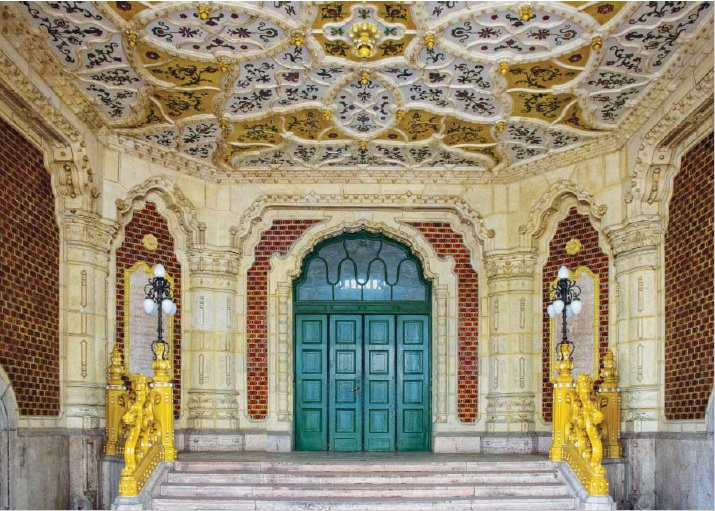
Museum of Applied Arts, Budapest, 1893–1896. Open atrium with the principal gate
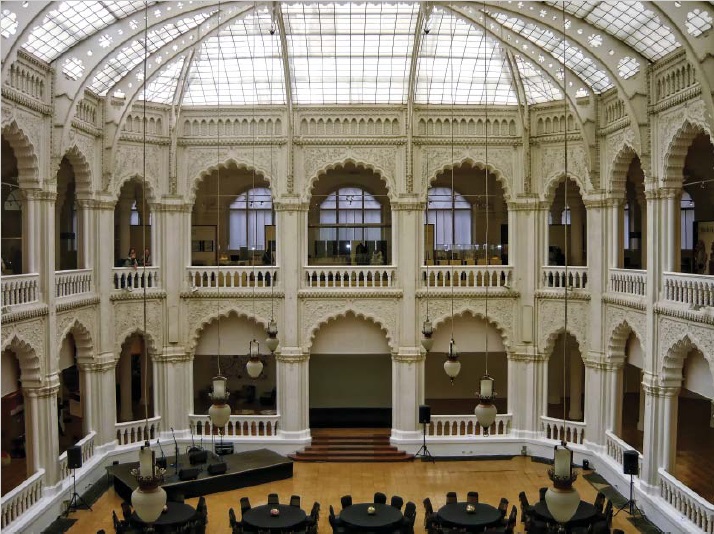
Museum of Applied Arts, Budapest, 1893–1896. Central exhibition hall
The difference between Wiehl’s and Lechner’s concept for the creation of a national style is nevertheless fundamental: while Wiehl followed quite closely the historical models for his buildings, Lechner interpreted the various details of historical or exotic architecture very freely, combining them in a new artistic synthesis, and in fact moulding them gradually into an idiosyncratic personal style.
II.
Lechner’s approach of liberating himself from the original models, and using only a few details from other sources to make a creatively novel combination, gradually came to dominate the architectural tendencies of the 1890s. The aim of inventing a modern style appropriate to the needs of modern life rapidly became more acceptable, indeed became the hallmark of divergent stylistic experiments in architecture all over Europe. This represented a paradigm shift in aesthetic orientation, as modernity now won the upper hand. It was a shift against historical tradition in favour of a quest for “new-ness”, which should be what the Germans call “zeitgemäß”.

Museum of Applied Arts, Budapest, 1893–1896. Pierced ceiling of the inner atrium
This meant giving priority to fulfilling the requirements that people would have in a modernising society. It heralded the new age of individualism and thirst for progress which was spurring the nations of Europe (at least their political and cultural elite) to pursue modernisation, and which made daring experiments in the field of culture suddenly acceptable. But this decade also gave birth to many local styles, which were duly labelled as “national” styles representing the taste and temperament of the different nations (in Anglo-American scholarship, vernacular is the preferred phrase for these artistic endeavours, but it is a terminology that, perhaps unconsciously, blurs the focus of the original agenda of the architects concerned). These aesthetic developments proceeded in tandem with the construction of a modern state for a modern nation.16
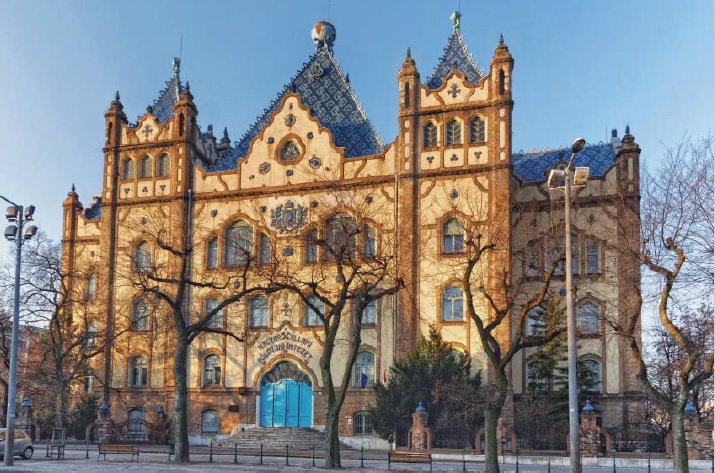
Geological Institute, Budapest, 1897–1899. View of the principal façade
Within the process of constructing the nation and modernising its society (which, throughout Europe, meant industrialisation and urbanisation) architecture played an increasingly important role. The Paris World Fair of 1889 again exerted a strong influence on the different nations, inspiring them to construct their own unique styles, and this trend was confirmed at all the subsequent international shows.17 The evidence for a highly developed national culture based on strong national identity (at that time positively evaluated), was to be provided by a flourishing modern art and architecture distinguishable from that of all other nations. It had become an intellectual and ethical obligation for the elite of any nation to produce a highly individual, and therefore exclusively national, art and architecture as a sign of modern civilisation. By the same token, it had become axiomatic internationally that nations should be significantly idiosyncratic in most aspects of their culture. The result of these assumptions was that constructing a “national” vocabulary of aesthetic forms became the ideal for many ambitious artists and theoreticians. By 1900, most European nations, or at least their artistic elite and leading ideologues, were typically demanding the cultivation of a specifically national style that should, of course, be unique, but also plausibly be legitimated by reference to its authentic roots.
It was not only Lechner who dreamt about a Magyar form-language and looked into the treasure trove of folk ornaments in native peasant culture; this was the preoccupation of Scandinavian, Polish, Slovak and Russian architects, painters, illustrators and designers.18 The folkloristic or ethnographic turn was a common European phenomenon,19 at least where it was not completely stifled by urbanisation. The amazing variety of individual artistic and architectural experiments could nevertheless on occasion achieve a more formal cohesion through the “master classes” of architecture (e.g. the Wagner School)20 that existed amongst individual architects working towards a nationally idiosyncratic aesthetic. The cult of artistic creativity and individualism indeed inflated the hubris of the architects, while the influence of the Zeitgeist also made it possible for an individual genius to create a style of his own, something that would have been prevented by the professional consensus of the previous generation dominated by the academy. Although Lechner himself had doubts as to whether he, as an individual, could create a new style,21 this became the legitimate ambition of his younger colleagues. In Austria, Bohemia and Hungary architects like Olbrich, Kotěra, Plečnik and Lajta all aspired to an individual modern style that would nevertheless also be appropriate for the nation to adopt as a style both modern and national. (In Otto Wagner’s case, it was for the Empire.)
At the international exhibitions for art and design it became obligatory to stress local and national identity coupled with the slogan of artistic renewal. This was the framework that afforded a chance to call attention to multifarious new products and to give individualism a form of cohesion. The hallmark of any cultural community (no matter whether it be a nation state or an ethnic minority like the Finns living within the bounds of the Tsarist Empire) was to elaborate its own aesthetics.22
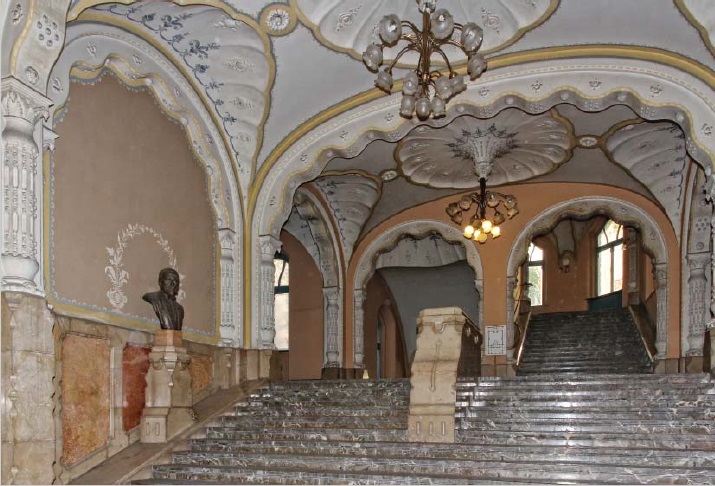
Geological Institute, Budapest, 1897–1899. Entrance Hall
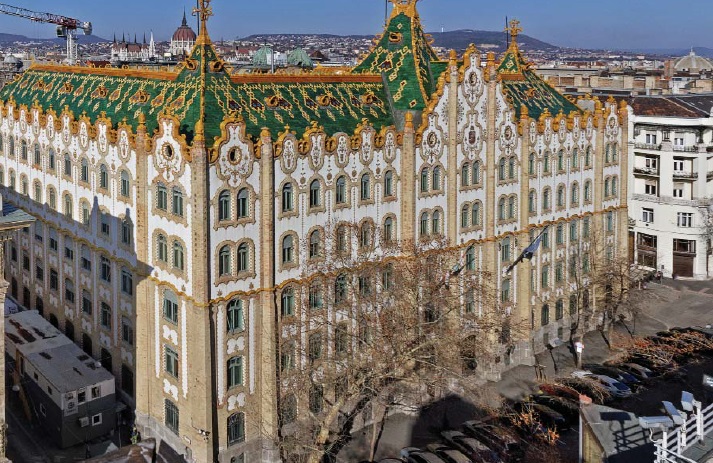
Postal Savings Bank, Budapest, 1900–1901
Moving on from the revivalism of the previous generation, the sons of the latter prized both innovation and the creation of new aesthetic forms that would make them internationally “visible”. Even the Austrians wanted to create an Austrian style in Vienna, although this to some extent contradicted the ideology of empire.23
Where, then, does Lechner stand in this age of self-conscious individualism?
At the turn of the century there were only a couple of architects who straddled the old order and the new (Historicism and Modernism) and who were capable of creating an influential innovative style: Otto Wagner (1841–1918) and Ödön Lechner (1845–1914).24 The majority of those experimenting with Art Nouveau and Secession were considerably younger than them and had turned against Academic Historicism. (The so-called “rebellion of the sons” was visually evident.)25
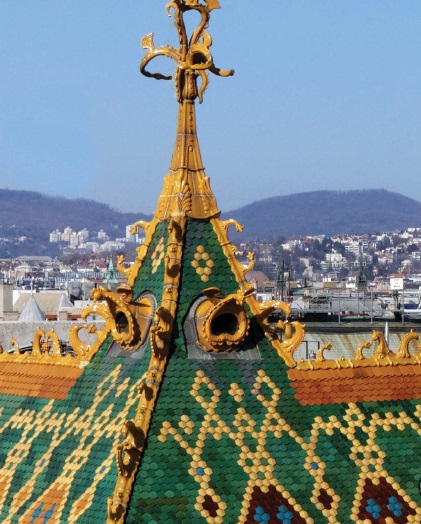
Postal Savings Bank, Budapest, 1900–1901. Detail of roof
The last twenty-five years before the outbreak of the First World War saw a building boom in Central Europe and appear in retrospect as a golden age for architects. Each region and nation reacted to its own historical and ethnic traditions, as well as facing different crises, whether social or bound up with ethnicity. Nevertheless, there remained two major obligations for artists and architects which influenced mind, spirit and soul: these were the urgent need for modernisation coupled with the requirements of patriotism, the unequivocal necessity to serve their own communities. According to their local social and national circumstances, but also motivated by individual character and temperament, these practitioners created idiosyncratic styles which yet were labelled national. Their work had no common stylistic denominator other than the quotation of vernacular elements, but that did not necessarily preclude it being regarded as “national”.
The very youngest (the “grandsons” born after 1880) represented an even newer approach, having acute socio-political sensitivity to regional cultural heritage within broader national cultures (e.g. Moravia or Transylvania).26 In Hungary a group of young architects with Károly Kós at their head27 devoted themselves to the architectural heritage of Transylvania.
Lechner lived and worked through three different generations of architects; as one of the “fathers” (i.e. one of the Historicist generation) he was a maverick, a non- conforming romantic. Then he constructed his own style step by step and invented the “Magyar style” in the face of the criticism and envy of leading members of his generation,28 but not under the influence of Art Nouveau theories. Consequently the rebellious “sons”, the fin-de-siècle Hungarian architects such as Béla Lajta, Flóris Korb and Kálmán Giergl or Zoltán Bálint and Lajos Jámbor, Marcell Komor and Dezső Jakab took him to their hearts and formed retrospectively the so-called “Lechner School”, which however was only nominally a “school”.29 Those closest to the ageing master helped him to realise some of his last projects and disseminated some of his formal stylistic inventions.
Finally the “grandsons”, the socially committed “vernacularist” generation of modern Hungarian architects (called “The Young”)30 continued to accept his agenda for creating a Hungarian style, but not his individual style, nor his “vocabulary of forms”. These youngest architects and designers constructed another vocabulary of forms based on local materials and proportions going back to local vernacular architectural heritages within historical Hungary, a style into which they integrated elements from contemporary Finnish and (to a lesser extent) German and English architecture. While they may be seen broadly speaking as Lechner’s heirs, they were so on an exclusively intellectual-emotional level. They represented the last generation of experimenters before the First World War swept away all possibilities to create a better future for these communities. In the field of music, something similar was undertaken by Béla Bartók and Zoltán Kodály. They were all cultural modernisers, but lacked the dogmatism of the contemporary political avant-garde. They successfully created a symbiosis between modernity and local tradition for the sake of stimulating social reform through the arts.
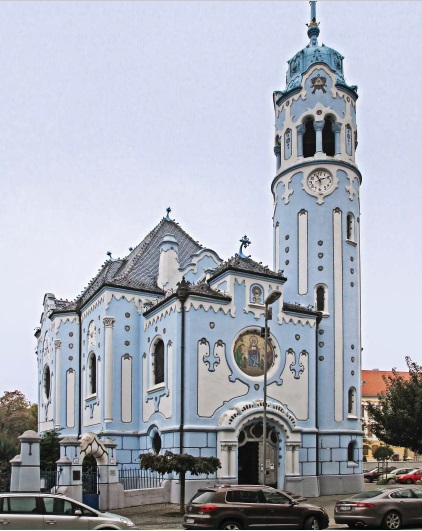
Saint Elizabeth Church, 1907, Pozsony/Bratislava, Slovakia
The curious fact that Lechner, the inventor of the “Magyar style” became after 1902 a kind of “holy fool” (and practically persona non grata in the eyes of the Hungarian authorities) is an intricate story involving the rivalry of architectural lobbies, political manoeuvring and other factors. How this came about cannot be explained within the short space of this overview, but it represented a nasty example of malevolent treatment of a great visionary by jobsworths and opportunists.
All the theoretically important writings and manifestos of Lechner date from around this time.31 Such declarations and statements need to be seen in the context of the polarised political struggles of the Hungarian state within the Austro- Hungarian Empire, and also in the context of the unhealthy internal political culture of Hungary from about 1903 onwards. Within a few years Budapest became a battleground of different trends: styles and groupings embraced sharply opposed political agendas and ideological arguments in order to gain more power and influence within the cultural field.32 Fierce polemics in the press meant that those who were not well organised with lobbies and networks could expect to be marginalised at best, demonised at worst.
For a daydreamer like Lechner, who was not a good networker and hopeless at self promotion, this new scene was a veritable nightmare. It is not surprising that he became marginalised in an ambience where the skills of manipulation, lobbying and the smearing of opponents were more valuable than idealism or integrity. Latterly he was patronised as a saintly eccentric old man, spending his time in the Artists’ Café dreaming of new projects that could never be realised. One hundred years after his death he would finally deserve an exhaustive professional monograph; he would also deserve that the buildings which he designed, and which are, after all, not so numerous, should be properly protected and restored.
(This essay is based on a contribution to the following volume, just published in Budapest: Ödön Lechner in Context. Studies of the international conference on the occasion of the 100th anniversary of Ödön Lechner’s death. Edited by Zsombor Jékely. Budapest: Museum of Applied Arts, 2015. ISBN 978-615-5217-21-0, 232 pp. Our thanks to Zsombor Jékely and the Museum of Applied Arts for permission to publish our version of the text, and to József Sisa for providing us with the colour photographs.)
1 Brandow-Faller 2011, 182–196.
2 Rudolf Wiegmann, “Gedanken über die Entwicklung eines zeitgemässen nationalen Baustyls”, Allgemeine Bauzeitung 6, 1841, 207.; Klaus Dohmer, In welchem Style sollen wir bauen? Architekturtheorie zwischen Klassizismus und Jugendstil, München, 1976, 102.
3 Miller-Lane 1991, 111–117.
4 The collector of the documents on Lechner and author of the first scholarly monograph on him was Ferenc Vámos. See: Vámos 1927; Vámos 1942.
5 Nemes 1980; Nemes 1991; Nemes 1993.
6 János Gerle (1947–2012) architect and architectural historian, editor of the series on Hungarian architects issued by the publishing house Holnap, and the editor of numerous important sources on Hungarian architecture. See Gerle 1992, 1997; János Gerle, A pénz palotái [Palaces of money], Budapest, 1994.
7 Gerle–Kovács–Makovecz 1990.
8 Gerle 2003.
9 Moravánszky 1988; Moravánszky 1998.
10 Cat. Budapest, 1985.
11 Hippolyte Taine (1828–1893). French historian. His theory that the milieu influenced artistic creation offered a strong argument for national pluralism both in literature and the fine arts. See his Philosophie de l’art, 5 vols, Paris, 1866–1882.
12 On the critical reflection of the Paris World Exhibition of 1878 see: Bela Ney’s report cited in Székely 2012, 96.
13 Marek 2004.
14 Vybíral 2010.
15 Jindřich Vybíral, “Die Kunst muss aus nationalem Boden hervorgehen”. Die Erfindung des tschechischen Nationalstils, in Matthias Krüger und Isabella Woldt (eds.), Im Dienst der Nation. Identitätsstiftungen und Identitätsbrüche in Werken der bildenden Kunst, Berlin, 2011, 77–94.
16 The concept that a nation can prove its excellence through producing art (high culture) on an exceptionally exquisite level was a common belief of all nations from the Enlightenment onwards, but became a subject of competition especially in the World Exhibitions.
17 Not only in Paris, but in Chicago (1894) and at the international arts and crafts exhibitions (such as Milan 1906).
18 See from the extended literature: Howard 1996.
19 The Celtic revival, the Czech Ethnographic Exhibition in 1895, the Zakopane Style, the Russian ethnographic interest of Russian painters in the 1890s are the most well-known examples of this trend.
20 See: Pozzetto 1980.
21 Ödön Lechner, “A magyar épités” [Hungarian building], Jövendő 1, no. 33, 1903, 32.
22 Howard 1996.
23 In 1898 the art critic Hermann Bahr demanded of the Viennese Secessionists the creation of an Austrian art par excellence, Bahr 1898.
24 Ilona Sármány, “Sorspárhuzamok a századfordulón” – Otto Wagner és Lechner Ödön [Parallel destinies at the turn of the century – Otto Wagner and Ödön Lechner], in Éva Somogyi (ed.), Polgárosodás Közép-Európában [Development of a bourgeois society in Central Europe], Budapest, 1991, 341–355.
25 Carl E. Schorske, Fin-de-siècle Vienna, New York, 1981.
26 Examples for this regional inspiration were the wooden architecture of the Zakopane region, the medieval churches and manor houses in Transylvania, or the northern brick architecture in Germany.
27 Anthony Gall, Kós Károly műhelye – Tanulmány és adattár. The Workshop of Károly Kós – Essays and Archives, Budapest, 2002.
28 His colleague of great professional authority, Alajos Hauszmann, criticised Lechner’s attempts to create a national style in 1903, in his inauguration speech as Rector of the Technical University of Budapest. Alajos Hauszmann, Székfoglaló beszéd [Inauguration speech], Budapest, 1903.
29 János Gerle, “A Lechner követőkről” [On Lechner’s followers], in Cat. Budapest, 1985, 74–82;
Eszter Gábor, “A Lechner-iskola” [The Lechner school], in Beke 2002, 210–218.
30 Architects belonging to this group were: Dénes Györgyi, Béla Jánszky, Lajos Kozma, Károly Kós, Valér Mende, Lajos Tátray, Dezső Zrumeczky. See on this group: Eszter Gábor, “Magyar formanyelv – Lechnertől távolabb” [Hungarian form-language – farther from Lechner], in Beke 2002, 218–224.
31 Ödön Lechner, “Magyar formanyelv nem volt, hanem lesz” [There has never been a Hungarian form-language, but there will be one], Művészet, 5/1, 1906, 1–18, and Ödön Lechner, “Önéletrajzi vázlat” [Autobiographical sketch], A ház 4/9–10, 1911, 343–356, reprinted in Gerle 2003.
32 The combatant “battlefield” of the different trends in painting can be followed in art criticism. See: Árpád Timár (ed.), “Az utak elváltak”. A magyar képzőművészet új utakat kereső törekvéseinek sajtóvisszhangja [“Taking separate roads”. Press echoes of the search for new paths in Hungarian fine arts], Szöveggyűjtemény [Anthology], vol. 1, 1901–1908 and vol. 2, 1909–1910, Pécs – Budapest 2010. There is no anthology yet covering the rivalry of architectural styles and ideologies of the age.







You have to log in or registrate for writing comments.